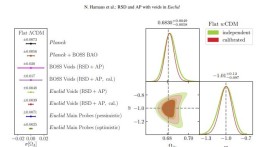Assistant Professor Alice Pisani Co-Published in the Astronomy & Astrophysics Journal
POSTED ON: May 19, 2022

Figure 7 from the publication.
Assistant Professor of Physics, Alice Pisani, has co-published in the Astronomy & Astrophysics Journal (Vol. 658, February 2022 Issue). The publication is on, “Euclid: Cosmological forecasts from the void size function.”
You can read more about the research here.
Abstract
Euclid is poised to survey galaxies across a cosmological volume of unprecedented size, providing observations of more than a billion objects distributed over a third of the full sky. Approximately 20 million of these galaxies will have their spectroscopy available, allowing us to map the three-dimensional large-scale structure of the Universe in great detail. This paper investigates prospects for the detection of cosmic voids therein and the unique benefit they provide for cosmological studies. In particular, we study the imprints of dynamic (redshift-space) and geometric (Alcock–Paczynski) distortions of average void shapes and their constraining power on the growth of structure and cosmological distance ratios. To this end, we made use of the Flagship mock catalog, a state-of-the-art simulation of the data expected to be observed with Euclid. We arranged the data into four adjacent redshift bins, each of which contains about 11 000 voids and we estimated the stacked void-galaxy cross-correlation function in every bin. Fitting a linear-theory model to the data, we obtained constraints on f/b and DMH, where f is the linear growth rate of density fluctuations, b the galaxy bias, DM the comoving angular diameter distance, and H the Hubble rate. In addition, we marginalized over two nuisance parameters included in our model to account for unknown systematic effects in the analysis. With this approach, Euclid will be able to reach a relative precision of about 4% on measurements of f/b and 0.5% on DMH in each redshift bin. Better modeling or calibration of the nuisance parameters may further increase this precision to 1% and 0.4%, respectively. Our results show that the exploitation of cosmic voids in Euclid will provide competitive constraints on cosmology even as a stand-alone probe. For example, the equation-of-state parameter, w, for dark energy will be measured with a precision of about 10%, consistent with previous more approximate forecasts.




